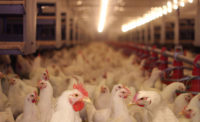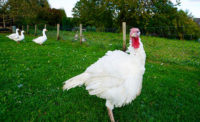As a member of the Millennial generation, I have gained a different perspective on the world we live in compared with earlier generations. Similar to most Millennials, I embrace social media and technology. Having a farming background has given me the insight to being both a producer and a consumer; however, being part of this generation has also shown me how far removed today’s consumers are from their food supply.
Usually, the way they receive their information about animal production is through the Internet. As the saying goes, “Don’t believe everything you read on the Internet.” This holds true for humane slaughter. There are tons of misconceptions about what actually occurs during processing, and that leads to confusion and rejection. Slaughter, in general, has always been the elephant in the room. Everyone knows it happens, but they aren’t sure how it happens and don’t want to ask because they may not like what they find out. I choose to approach this controversial topic with confidence because I think it is something that we need to discuss and bring to the foreground.
As a meat lover, humane slaughter has always been extremely important in my life. I want to know where my products come from and how they are harvested. But it is one of the hardest things to talk about. Growing up on a farm, we slaughtered our chickens at home, but we sent our sheep and cattle to the local meat shop for processing. I was fascinated by the fact we could take a live animal to the shop and then go back to pick up fresh, yummy meat. My parents were always very good about telling us why we processed the animals and that caring for them was very important. It wasn’t until I started my undergraduate degree at the University of Wisconsin-River Falls that I realized how important meat production was not only my family, but to the entire world. It was also when I learned my generation has been so far removed from its food source that they decide to act before they educate themselves about meat production.
Through my education, I became interested in the how, where and why behind animal production. My interest really peaked during my sophomore year when I approached Dr. Kurt Vogel about completing research and conducting hands-on learning in meat processing. The following afternoon, we sat down and came up with a few projects. The first was developing an animal welfare audit at a small veal processing plant. In doing so, I learned a tremendous amount about processing. It absolutely amazed me how every part of the animal is used and nothing was wasted. I realized the importance of animals, not only to feed us, but also to supply us with our everyday needs.
After completing the animal welfare audit, I had the privilege to go back to the plant and do some additional work on stunning parameters of veal calves. As with all stun procedures, my biggest concerns have always been making sure the animal is rendered unconscious and they feel no pain during the process. This is where proper stunning and exsanguination come in. However, what sets veal apart from other cattle is the fact their central nervous tissue is regularly used for human consumption. We wanted to test a new way of stunning veal that would leave the brain intact but would also be successful at rendering the animal unconscious. So we developed a project that focused on two approved stunning methods for veal slaughter.
For both stunning methods, we wanted to deliver a powerful blow directly to the head of the animal to induce and maintain unconsciousness. It was also important that the stun would last for the duration of exsanguination. Blunt force trauma was applied using a non-penetrative captive bolt gun. This on its own has the potential for animals to return to consciousness since the brain is not damaged. To address this, we added a second treatment group in which we followed the application of the stun to the head with an electrical stun to the heart. This would keep the animal from returning to consciousness and was previously addressed in earlier research with market hogs by Vogel. Additionally, research was needed to evaluate lean and light meat qualities of the veal, since it is important for veal marketing. The main questions we asked ourselves during our study were: What are the differences in stunning treatments with regard to both stun effectiveness and meat quality?
To measure the effectiveness of stun, we looked at several objective measurements to evaluate initial and maintenance of unconsciousness after stun application. These included corneal reflex (blink in response to eye touch), reflex to nose pinch, vocalization, rhythmic breathing and righting reflex (attempt to regain regular posture). We also monitored heart beat using an ECG (electrocardiogram). In addition to sensibility, we also measured meat quality since this would be important for consumers.
During the study, all animals were rendered completely unconscious throughout the stunning and exsanguination process regardless of which stunning procedure was used. Ninety-four percent of the animals that were stunned traditionally still had a measurable heart beat whereas only 15 percent of those that received the electrical shock to the heart after the non-penetrating stun had a measurable response detectable during exsanguination. With this result, we were able to answer our first question: Yes, we were able to induce a proper stun in all animals and therefore, our stunning procedures were effective.
What was even more interesting was what we discovered during our meat quality checks. Animals that received the electrical stun to the heart after the initial stun to the head had a smaller amount of blood loss that those that received captive bolt stun alone. This also led to the discovery that those animals had darker colored meat. Everything else was the same, which was quite surprising to me. Overall, we concluded that although using the additional electric stimulation to the heart would decrease the heartbeat of the animals and could be a useful means of stunning, it may change some meat properties (i.e. give a darker meat) that may negatively affect the veal quality. For more information on the study, it is available from the Journal of Animal Science under the title, “Assessment of nonpenetrating captive bolt stunning followed by electrical induction of cardiac arrest in veal calves”.
Although most Millennials have detached themselves from their food supply, I choose to educate myself and others about what really occurs behind the doors of production. I pride myself on being a Millennial who stays connected with all sides of meat production. It has become my passion, and I am empowered to build my career around this field of study. The research I conducted has not only opened my eyes to what research actually is, but also to what a Millennial can do to change the world in a positive way.
It’s a humbling feeling knowing that I positively affect the experiences that many consumers have by supplying them with quality meat products. It’s also very rewarding to know that I served that animal the best I possibly could by properly rendering them unconscious so it would not feel pain during processing. This work made me proud to be a meat scientist, not only because I help feed the world, but because I also have seen firsthand that we process animals the best way we possibly can to avoid unnecessary pain and suffering. I know that Millennials care about this topic; however, the proper education and positive feedback is not prominent on the Internet. I aim to change the way humane slaughter is viewed and we must be ready to embrace the views of young consumers as they are the consumers of our products now and in the future. NP






Report Abusive Comment